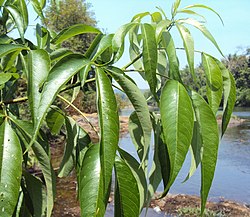Crateva magna
| Crateva magna | |
|---|---|

| |

| |
| Scientific classification | |
| Kingdom: | Plantae |
| Clade: | Tracheophytes |
| Clade: | Angiosperms |
| Clade: | Eudicots |
| Clade: | Rosids |
| Order: | Brassicales |
| Family: | Capparaceae |
| Genus: | Crateva |
| Species: | C. magna
|
| Binomial name | |
| Crateva magna | |
| Synonyms[1] | |
| |
Crateva magna is a species of flowering plant in the family Capparaceae.[1][2]
It is a small wild or cultivated tree native to Bangladesh, Borneo, Cambodia, China, India, Indonesia, Japan, Java, Laos, Malaysia, Myanmar, Thailand, Tibet, and Vietnam.[1][3] It is often found along streams,[4] and also in dry, deep boulder formations in Sub-Himalayan tracts.
Crateva nurvala is now generally considered to be a synonym of this species.[5]
Uses
[edit]Medicinal uses
[edit]The dried bark is used as a raw drug in traditional systems of medicine in India, such as Ayurveda, siddha etc. A decoction of the bark is internally administered to cure diseases like renal calculi, dysuria, helminthiasis, inflammations and abscesses. The decoction has carminative, laxative, thermogenic, diuretic, lithontriptic, expectorant and demulcent actions.[6] The leaf and stem bark have been evaluated for their antioxidant activity and the inhibition of key enzymes relevant to hyperglycemia.[7]
Parts used
[edit]The dried bark and leaves are used for medicinal purposes.[8]
References
[edit]- ^ a b c "Crateva magna (Lour.) DC". Plants of the World Online. The Trustees of the Royal Botanic Gardens, Kew. n.d. Retrieved July 3, 2025.
- ^ "Crateva magna (Lour.) DC". Catalogue of Life. Species 2000. n.d. Retrieved July 3, 2025.
- ^ Mingli Zhang and Gordon C. Tucker (2008), "Crateva magna (Loureiro) Candolle, Prodr. 1: 243. 1824", Flora of China Online, vol. 7
- ^ Nalini, MS; Mahesh, B; Tejesvi, MV; Prakash, HS; Subbaiah, V; Kini, KR; Shetty, HS (2005). "Fungal endophytes from the three-leaved caper, Crataeva magna (Lour.) DC. (Capparidaceae)". Mycopathologia. 159 (2): 245–9. doi:10.1007/s11046-004-5497-y. PMID 15770450. S2CID 8488022.
- ^ "Images and Information of Crataeva magna". Indian Medicinal Plants Database. Institute for Ayurveda and Integrative Medicine.
- ^ Bhattacharjee, Atanu; Shashidhara, Shastry Chakrakodi; Aswathanarayana (2012). "Phytochemical and ethno-pharmacological profile of Crataeva nurvala Buch-Hum (Varuna): A review". Asian Pacific Journal of Tropical Biomedicine. 2 (2): S1162–8. doi:10.1016/S2221-1691(12)60379-7.
- ^ Loganayaki, Nataraj; Manian, Sellamuthu (2012). "Evaluation of Indian sacred tree Crataeva magna (Lour.) DC. For antioxidant activity and inhibition of key enzymes relevant to hyperglycemia". Journal of Bioscience and Bioengineering. 113 (3): 378–80. doi:10.1016/j.jbiosc.2011.10.020. PMID 22196938.
- ^ http://www.tkdl.res.in/tkdl/langdefault/common/Home.asp?GL=Eng[full citation needed] Archived July 23, 2013, at the Wayback Machine
External links
[edit] Data related to Crateva magna at Wikispecies
Data related to Crateva magna at Wikispecies Media related to Crateva magna at Wikimedia Commons
Media related to Crateva magna at Wikimedia Commons
- Medicinal plants of Asia
- Capparaceae
- Flora of Assam (region)
- Flora of Bangladesh
- Flora of Borneo
- Flora of Cambodia
- Flora of East Himalaya
- Flora of Hainan
- Flora of India (region)
- Flora of Indo-China
- Flora of Indonesia
- Flora of Japan
- Flora of Java
- Flora of Laos
- Flora of Malaysia
- Flora of Myanmar
- Flora of South-Central China
- Flora of Southeast China
- Flora of Thailand
- Flora of Tibet
- Flora of Vietnam
- Plants described in 1790
- Taxa named by João de Loureiro
